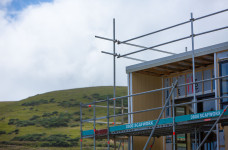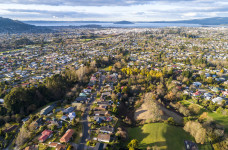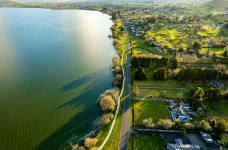Programme
Urban growth agenda
The urban growth agenda (UGA) is a government-wide programme to improve housing affordability by removing barriers to the supply of land and infrastructure and making room for cities to grow up as well as out.
UGA objectives
The UGA’s main objective are:
Affordable housing
Giving people more and better options for housing locations and types, to improve housing affordability in urban areas.
Emissions reduction
Encouraging, enabling, and incentivising lower emission urban form and construction.
Liveable and resilient cities
Making urban areas more accessible and inclusive, and increasing resilience to natural hazards and climate change impacts.
Focus areas
The UGA is focused on five areas, which are being delivered through urban growth partnerships, policy programmes, and system reforms across government.
Infrastructure funding, financing, and delivery
Create a more responsive supply of infrastructure and appropriate cost allocation.
Urban planning
Allow for cities to make room for growth, support quality-built environments and strategic integrated planning.
Urban Growth Partnership
Build stronger partnerships with iwi and Māori and between local and central government.
Levering and integrating transport
Invest in transport and land use to create low-carbon and well-connected public and other transport.
System coherence
Make sure that regulatory, institutional and funding settings are integrated and an urban development perspective is included across government reforms.
Urban growth partnerships
Under the urban growth agenda (UGA), central government is expected to partner with local governments and iwi so that government investment in infrastructure delivers connected, thriving and sustainable urban communities.
An important part of the urban growth partnerships is spatial planning, a long-term and integrated approach to land use and infrastructure planning.
A number of other central government agencies are involved in the Urban Growth Partnerships work, including:
- Ministry of Transport(external link)
- New Zealand Transport Agency(external link)
- Treasury(external link)
- Department of Internal Affairs(external link)
- Ministry of Business, Innovation and Employment(external link)
- Ministry for the Environment(external link)
- Kāinga Ora(external link).
Current partnerships
Urban growth partnerships have been progressed as part of the Government’s urban growth agenda (UGA) to improve co-ordination and alignment between central and local government and mana whenua in New Zealand’s high growth urban areas. Urban growth partnerships between the Government, local government and iwi have been established in six high growth urban areas.
The partnerships aim to improve outcomes around housing, land use and infrastructure planning.
Auckland
The Auckland housing and urban growth joint programme is a collaboration between Auckland Council and the Government to deliver shared housing and urban growth priorities in New Zealand’s largest urban centre. The programme covers both spatial priorities, for example, development opportunities arising from the City Rail Link, the City Centre to Mangere Light Rail Transit projects (Auckland Light Rail), Manukau centre and Drury, and policy priorities, such as how to deliver more affordable housing and quality intensification. A number of other government agencies are working alongside us and the Auckland Council in this partnership.
Greater Christchurch
The Whakawhanake Kāinga Committee is an urban growth partnership for the Greater Christchurch area. The partnership is between the Greater Christchurch Partnership, Ngāi Tahu and the Crown. To address existing challenges and position Greater Christchurch effectively for long-term growth the Committee is working together to create a well-functioning urban environment that supports the decarbonisation of transport and improves resilience, housing affordability and accessibility. An initial priority of the partnership is the preparation of a joint spatial plan and Mass Rapid Transport investigation. It is estimated that the joint spatial plan will be ready for public consultation in early 2023 and finalised by mid-2023.
Greater Christchurch Partnership(external link)
Cabinet paper - Urban Growth Partnership in Christchurch (PDF, 1.7 MB)
Hamilton - Auckland Corridor
The Hamilton-Auckland Corridor (H2A) was the first partnership in New Zealand to bring two regions, mana whenua, central and local government together to integrate and coordinate land use, network and social infrastructure planning and delivery. The Corridor connects two of New Zealand’s fastest-growing cities through an area of high natural and cultural importance and value. There is significant housing and employment growth potential at either end of the Corridor. This project is now being implemented by the Future Proof | Te Tau Tiitoki governance group.
The Hamilton-Auckland Corridor Plan was completed in December 2018 and updated in November 2020. The plan sets the vision, growth management objectives and programme for the corridor.
The Hamilton-Waikato Metropolitan Plan (Metro Spatial Plan) is being delivered through the Future Proof partnership and is one of the initiatives as part of the broader Hamilton to Auckland Corridor Plan. The Hamilton-Waikato metro area is an urban sub-region of the Waikato.
The Future Proof Strategy was updated in October 2021 to incorporate the Hamilton to Auckland (H2A) Corridor Plan and the Hamilton-Waikato Metropolitan Spatial Plan. This reflects the importance of the H2A corridor stretching through the north- Waikato and into Auckland, and the connections east towards Morrinsville and the Bay of Plenty.
Knowing our future by planning today - Future Proof (external link)
Cabinet paper - Hamilton-Auckland Corridor Partnership Plan and Programme (PDF, 2.7 MB)
Queenstown Lakes
Whaiora Grow Well Partnership for the Queenstown Lakes area was established in July 2021. The partnership is between Queenstown Lakes District Council, Kāi Tahu, and the Government. The purpose of the partnership is to manage growing tourism and housing pressures and to develop a long-term strategy and investment plan for the future development of the area that improves community wellbeing, maintains a world-class visitor experience and protects the environment. The Queenstown Lakes Spatial Plan sets out the partnership’s long-term approach to addressing these challenges. The partnership is now working together to deliver the joint programme of work identified in the Spatial Plan.
Queenstown Lakes Spatial Plan(external link)
Tauranga - Western Bay of Plenty
The Western Bay of Plenty requires a fundamentally different approach to managing growth to address interlinked urban development and housing issues and opportunities in the sub-region. The combination of multiple land use constraints and an over-reliance on private mobility means that the current growth model is increasingly unaffordable, unproductive and environmentally unsustainable. In August 2020, the Crown joined the region’s existing and longstanding SmartGrowth partnership.
SmartGrowth partnership(external link)
Cabinet paper - Tauranga-Western Bay of Plenty Urban Growth Partnership (PDF, 1.3 MB)
Wellington-Horowhenua Region
This emerging partnership is a collaborative approach to addressing the region’s housing and urban development issues, with a focus on aligned investment. Ten local authorities in Wellington-Wairarapa-Horowhenua, a number of iwi groups with facilitation and support from central government agencies have developed a full draft Wellington Regional Leadership Committee, including a high-level spatial plan and associated programme of initiatives. With focus on mode shift, access and housing affordability and exploring key development areas to understand how new government tools may be applied in these areas.
Wellington Regional Leadership Committee(external link)
Partnerships in development
Northland-Auckland Corridor
Officials are currently exploring a possible urban growth partnership for the dynamic corridor that stretches from Northland to Auckland. Based on the Hamilton-Auckland corridor model, this could see an enduring partnership between local councils, central government and iwi to manage the high level of current and predicted urban growth, including spatial alignment around the significant current rail and roading improvements. This also includes how it may fit with other existing housing, economic and social development initiatives and partnerships.
Waka Kotahi’s Auckland to Whangarei Corridor Management Plan(external link)



